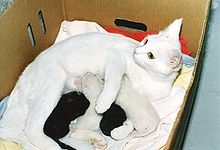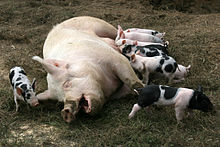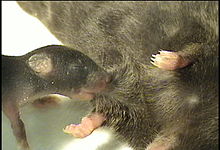- Lactation
-
 Kittens nursing
Kittens nursing
 Lactation of pigs
Lactation of pigs
Lactation describes the secretion of milk from the mammary glands and the period of time that a mother lactates to feed her young. The process occurs in all female mammals, however it predates mammals.[1] In humans the process of feeding milk is called breastfeeding or nursing. In most species milk comes out of the mother's nipples; however, the platypus (a non-placental mammal) releases milk through ducts in its abdomen. In only one species of mammal, the Dayak fruit bat, is milk production a normal male function. In some other mammals, the male may produce milk as the result of a hormone imbalance. This phenomenon may also be observed in newborn infants as well (for instance witch's milk).
Galactopoiesis is the maintenance of milk production. This stage requires prolactin (PRL) and oxytocin.
Contents
Purpose
The chief function of lactation is to provide nutrition and immune protection to the young after birth. In almost all mammals, lactation induces a period of infertility, which serves to provide the optimal birth spacing for survival of the offspring.[2]
Human lactation
 When the baby sucks its mother's breast, a hormone called oxytocin compels the milk to flow from the alveoli, through the ducts (milk canals) into the sacs (milk pools) behind the areola and then into the baby's mouth
When the baby sucks its mother's breast, a hormone called oxytocin compels the milk to flow from the alveoli, through the ducts (milk canals) into the sacs (milk pools) behind the areola and then into the baby's mouthHormonal influences
From the twenty-fourth week of pregnancy (the second and third trimesters), a woman's body produces hormones that stimulate the growth of the milk duct system in the breasts:
- Progesterone—influences the growth in size of alveoli and lobes, high levels of progesterone inhibit lactation before birth. Progesterone levels drop after birth, this triggers the onset of copious milk production.[3]
- Oestrogen—stimulates the milk duct system to grow and differentiate. Like progesterone high levels of oestrogen also inhibit lactation. Oestrogen levels also drop at delivery and remain low for the first several months of breastfeeding.[3] It is recommended that breastfeeding mothers avoid oestrogen-based birth control methods, as a spike in estrogen levels may reduce a mother's milk supply.
- Prolactin—contributes to the increased growth and differentiation of the alveoli, also influences differentiation of ductal structures. High levels of prolactin during pregnancy and breastfeeding also increase insulin resistance, increase growth factor levels (IGF-1) and modify lipid metabolism in preparation for breastfeeding. During lactation prolactin is the main factor maintaining tight junctions of the ductal epithelium and regulating milk production through osmotic balance.
- Growth hormone is structurally very similar to prolactin and contributes to its galactopoietic function.
- ACTH and glucocorticoids have an important lactation inducing function in several animal species. ACTH is thought to contribute as it is structurally similar to prolactin. Glucocorticoids play a complex regulating role in the maintenance of tight junctions.
- TSH is a very important galactopoietic hormone, its levels are naturally increased during pregnancy.
- Oxytocin—contracts the smooth muscle of the uterus during and after birth, and during orgasm(s). After birth, oxytocin contracts the smooth muscle layer of band-like cells surrounding the alveoli to squeeze the newly-produced milk into the duct system. Oxytocin is necessary for the milk ejection reflex, or let-down to occur.
- Human placental lactogen (HPL)—From the second month of pregnancy, the placenta releases large amounts of HPL. This hormone appears to be instrumental in breast, nipple, and areola growth before birth.
- Follicle stimulating hormone (FSH)
- Luteinizing hormone (LH)
By the fifth or sixth month of pregnancy, the breasts are ready to produce milk. It is also possible to induce lactation without pregnancy.
Lactogenesis I
During the latter part of pregnancy, the woman's breasts enter into the Lactogenesis I stage. This is when the breasts make colostrum (see below), a thick, sometimes yellowish fluid. At this stage, high levels of progesterone inhibit most milk production. It is not a medical concern if a pregnant woman leaks any colostrum before her baby's birth, nor is it an indication of future milk production.
Lactogenesis II
At birth, prolactin levels remain high, while the delivery of the placenta results in a sudden drop in progesterone, estrogen, and HPL levels. This abrupt withdrawal of progesterone in the presence of high prolactin levels stimulates the copious milk production of Lactogenesis II.
When the breast is stimulated, prolactin levels in the blood rise, peak in about 45 minutes, and return to the pre-breastfeeding state about three hours later. The release of prolactin triggers the cells in the alveoli to make milk. Prolactin also transfers to the breast milk. Some research indicates that prolactin in milk is greater at times of higher milk production, and lower when breasts are fuller, and that the highest levels tend to occur between 2 a.m. and 6 a.m.[4]
Other hormones—notably insulin, thyroxine, and cortisol—are also involved, but their roles are not yet well understood. Although biochemical markers indicate that Lactogenesis II begins about 30–40 hours after birth, mothers do not typically begin feeling increased breast fullness (the sensation of milk "coming in the breast") until 50–73 hours (2–3 days) after birth.
Colostrum is the first milk a breastfed baby receives. It contains higher amounts of white blood cells and antibodies than mature milk, and is especially high in immunoglobulin A (IgA), which coats the lining of the baby's immature intestines, and helps to prevent pathogens from invading the baby's system. Secretory IgA also helps prevent food allergies.[5] Over the first two weeks after the birth, colostrum production slowly gives way to mature breast milk.[3]
Lactogenesis III
The hormonal endocrine control system drives milk production during pregnancy and the first few days after the birth. When the milk supply is more firmly established, autocrine (or local) control system begins. This stage is called Lactogenesis III
During this stage, the more that milk is removed from the breasts, the more the breast will produce milk.[6][7] Research also suggests that draining the breasts more fully also increases the rate of milk production.[8] Thus the milk supply is strongly influenced by how often the baby feeds and how well it is able to transfer milk from the breast. Low supply can often be traced to:
- not feeding or pumping often enough
- inability of the infant to transfer milk effectively caused by, among other things:
- jaw or mouth structure deficits
- poor latching technique
- rare maternal endocrine disorders
- hypoplastic breast tissue
- a metabolic or digestive inability in the infant, making it unable to digest the milk it receives
- inadequate calorie intake or malnutrition of the mother
Milk ejection reflex
The release of the hormone oxytocin leads to the milk ejection or let-down reflex. Oxytocin stimulates the muscles surrounding the breast to squeeze out the milk. Breastfeeding mothers describe the sensation differently. Some feel a slight tingling, others feel immense amounts of pressure or slight pain/discomfort, and still others do not feel anything different.
The let-down reflex is not always consistent, especially at first. The thought of breastfeeding or the sound of any baby can stimulate this reflex, causing unwanted leakage, or both breasts may give out milk when an infant is feeding from one breast. However, this and other problems often settle after two weeks of feeding.[citation needed] Stress or anxiety can cause difficulties with breastfeeding.
A poor milk ejection reflex can be due to sore or cracked nipples, separation from the infant, a history of breast surgery, or tissue damage from prior breast trauma. If a mother has trouble breastfeeding, different methods of assisting the milk ejection reflex may help. These include feeding in a familiar and comfortable location, massage of the breast or back, or warming the breast with a cloth or shower.
Afterpains
A surge of oxytocin also causes the uterus to contract. During breastfeeding, mothers may feel these contractions as afterpains. These may range from period-like cramps to strong labour-like contractions and can be more severe with second and subsequent babies. Some women's breasts also become dry and chapped and even crack open and bleed while breast feeding. Rubbing lanolin on the nipples and areola can help with those problems. [9]
Lactation without pregnancy, induced lactation, relactation
In humans induced lactation and relactation has been observed frequently in primitive cultures and demonstrated with varying success in adoptive mothers. It appears plausible that the possibility of induction of lactation in women (or females of other species) who are not biological mothers does confer an evolutionary advantage especially in groups with high maternal mortality and tight social bonds. [10] [11] The phenomenon has been also observed in most primates, some lemurs and dwarf mongooses.[12][13]
In humans lactation can be induced by a combination physical and psychological stimulation, by drugs or a combination of those methods. [14]
Also, some couples may use lactation for sexual purposes.
Rare accounts of male lactation (as distinct from galactorrhea) exist in historical medical and anthropological literature, although the phenomenon has not been confirmed by more recent literature. [15]
Evolution
Darwin correctly recognised that mammary glands developed from cutaneous glands and postulated the hypothesis that they evolved from glands in brood pouches of fish where they provided nourishment for eggs.[1] The later aspect of his hypothesis has not been confirmed, but recently the same mechanism has been postulated for early synapsids.[16] Instead the discus fish (Symphysodon aequifasciata) became known for (biparentally) feeding their offspring by epidermal mucus secretion.[17] A closer look reveals that similar to most mammals the secretion of the nourishing fluid may be controlled by prolactin.[18]
Later therapsids such as cynodonts appear to have secreted complex, nutrient-rich milk. This brought them evolutionary advantage by allowing a decline in egg size.[16]
During early evolution of lactation the secretion was through pilosebaceous glands and mammary hairs transported the nourishing fluids to the eggs or youngs. Later the development of the mammary patch rendered mammary hairs obsolete. [16]
Other well known example of nourishing young with secretions of glands is the crop milk of pigeons. Like in mammals and disc fish this also appears closely related to prolactin.[19] Other birds such as flamingos and penguins are utilizing similar feeding techniques.[20]
Further information: Evolution of mammals#Milk production (lactation)Further information: Mammary gland#EvolutionSee also
References
- ^ a b Capuco, A. V.; Akers, R. M. (2009). "The origin and evolution of lactation". Journal of Biology 8 (4): 37. doi:10.1186/jbiol139. PMC 2688910. PMID 19439024. http://www.pubmedcentral.nih.gov/articlerender.fcgi?tool=pmcentrez&artid=2688910.
- ^ McNeilly, A. S. (1997). "Lactation and fertility". Journal of Mammary Gland Biology and Neoplasia 2 (3): 291–298. doi:10.1023/A:1026340606252. PMID 10882312.
- ^ a b c Mohrbacher, Nancy; Stock, Julie (2003). The Breastfeeding Answer Book (3rd ed. (revised) ed.). La Leche League International. ISBN 0-912500-92-1.
- ^ Cregan M, Mitoulas L, Hartmann P (2002). "Milk prolactin, feed volume and duration between feeds in women breastfeeding their full-term infants over a 24 h period". Exp Physiol 87 (2): 207–14. doi:10.1113/eph8702327. PMID 11856965.
- ^ Sears, Martha; Sears, William (2000). The Breastfeeding Book. Little, Brown. ISBN 978-0-316-77924-5.
- ^ deCarvalho M, Anderson D, Giangreco A, Pittard W (1985). "Frequency of milk expression and milk production by mothers of non-nursing premature neonates". Am J Dis Child 139 (5): 483–5. PMID 3984973.
- ^ Hopkinson J, Schanler R, Garza C (1988). "Milk production by mothers of premature infants". Pediatrics 81 (6): 815–20. PMID 3368280.
- ^ Daly S, Owens R, Hartmann P (1993). "The short-term synthesis and infant-regulated removal of milk in lactating women". Exp Physiol 78 (2): 209–20. PMID 8471241.
- ^ Fray, Kathy (2005). Oh Baby...Birth, Babies & Motherhood Uncensored. Random House NZ. ISBN 1-86941-713-5.
- ^ Sobrinho, L. (2003). "Prolactin, psychological stress and environment in humans: adaptation and maladaptation". Pituitary 6 (1): 35–39. doi:10.1023/A:1026229810876. PMID 14674722.
- ^ Bose, C.; D'ercole, A.; Lester, A.; Hunter, R.; Barrett, J. (1981). "Relactation by mothers of sick and premature infants". Pediatrics 67 (4): 565–569. PMID 6789296.
- ^ König, B. (1997). "Cooperative care of young in mammals". Die Naturwissenschaften 84 (3): 95–104. Bibcode 1997NW.....84...95K. doi:10.1007/s001140050356. PMID 9112240.
- ^ Creel, S. R.; Monfort, S. L.; Wildt, D. E.; Waser, P. M. (1991). "Spontaneous lactation is an adaptive result of pseudopregnancy". Nature 351 (6328): 660–662. Bibcode 1991Natur.351..660C. doi:10.1038/351660a0. PMID 2052092.
- ^ "Relactation: an effective intervention to promote exclusive breastfeeding". Journal of tropical pediatrics 43 (4): 213–6. 1997. PMID 9283123.
- ^ http://www.scientificamerican.com/article.cfm?id=strange-but-true-males-can-lactate&sc=rss
- ^ a b c Oftedal, OT (2002). "The mammary gland and its origin during synapsid evolution". Journal of mammary gland biology and neoplasia 7 (3): 225–52. doi:10.1023/A:1022896515287. PMID 12751889.
- ^ Chong, K.; Joshi, S.; Jin, L. T.; Shu-Chien, A. C. (2006). "Proteomics profiling of epidermal mucus secretion of a cichlid (Symphysodon aequifasciata) demonstrating parental care behavior". Proteomics 6 (7): 2251. doi:10.1002/pmic.200500591. PMID 16385477.
- ^ Khong, H. K.; Kuah, M. K.; Jaya-Ram, A.; Shu-Chien, A. C. (2009). "Prolactin receptor mRNA is upregulated in discus fish (Symphysodon aequifasciata) skin during parental phase". Comparative Biochemistry and Physiology Part B: Biochemistry and Molecular Biology 153: 18. doi:10.1016/j.cbpb.2009.01.005.
- ^ Horseman, N. D.; Buntin, J. D. (1995). "Regulation of Pigeon Cropmilk Secretion and Parental Behaviors by Prolactin". Annual Review of Nutrition 15: 213. doi:10.1146/annurev.nu.15.070195.001241. PMID 8527218.
- ^ http://www.stanford.edu/group/stanfordbirds/text/essays/Bird_Milk.html
External links
- How mammals lost their egg yolks—Did mammals develop nutritional milk before or after they abandoned yolky eggs? (New Scientist, 18 March 2008)
Human physiology and endocrinology of sexual reproduction Menstrual and estrous cycle Gametogenesis Spermatogenesis (spermatogonium, spermatocyte, spermatid, sperm) · Oogenesis (oogonium, oocyte, ootid, ovum) · Germ cell (gonocyte, gamete)Human sexual behavior Sexual intercourse · Masturbation · Erection · Orgasm · Ejaculation · Insemination · Fertilisation/Fertility · Implantation · Pregnancy · Postpartum period · Mechanics of sexLife span Egg (biology) Reproductive endocrinology
and infertilityBreast Categories:- Animal physiology
- Breastfeeding
- Exocrine system
- Glands
- Mammals
- Milk
- Reproduction
- Secondary sexual characteristics
- Breast milk
Wikimedia Foundation. 2010.

